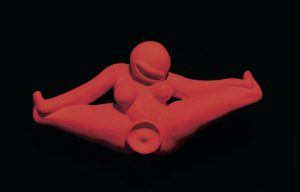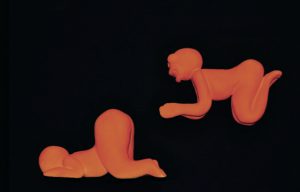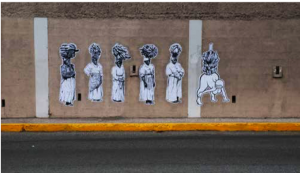Imani Catalog Entry
A note: I will engage with Johnson’s earthenware avatars as they are presented to us in the images. I know some of them are displayed on pedestals.
Johnson’s avatars act as a means of translating the Dancehall world to the art world and larger Jamaican society. Thus, the avatar which Johnson dubs “Pum-pum” is a bridge. The avatar is usually a figure or being which is the incarnation of God in human form. Thus, at the same time the avatar is a stand in or embodiment of another person or persons. The avatar in form, color, and presentation in Johnson’s work are meant to communicate the gender, social, and body politics of the the Dancehall world.

In Johnson’s work his avatars, Pum-pum, come out of a black background. There is a contrast created between the colors red and black. In this photographic presentation, the color Black becomes a means of making light. This is important for multiple reasons. Light is important to dance hall culture—it is a means of being seen in the dancehall space. This is very much rooted in invisibility of the black subjects who inhabit the dancehall space. More, the black background gives depth and accentuates the parts of the earthenware avatars’ body. Thus, we can see the curves of its breasts, legs, and head. The black background helps to create shadow on the red figures as well. This creation of light and shadow also allude to the figures emergence out of a black abyss. Coming out of darkness, instead of light (or a white background) hints at a relationship between the Dancehall present and the colonial and enslaved past of the black female body. Although Johnson’s avatar’s are hairless, their balloon-like curves, breasts, and butts allude to the black female. In coming to recognize that they stand in for black female bodies and the dancer’s movements in the dancehall, the avatars take on new meaning. The sexual violence experienced by black women emerge, forcing us to think about what it means for these figures to literally surface out of blackness. Simultaneously, the works sets up a relationship between red and black, conveying a contradiction. The red paint Johnson coats onto the ceramic form allude to the history of violence and bloodshed black women have endured. Moreover, the stark contrast between the red form and the black background are the means upon which we get the light and shadow affect. And this relationship between the two colors hints at the hyper visibility or proliferation of black women’s bodies in the Dancehall space (and public space generally). And thus of their, labor. This space both accentuates that body and its labor, but it also shadows that labor. Part of this shadowing is because of the way the public and private are queered. The sacred–in this case the Pum-pum–becomes that which is worshipped in public and not in the church. Sensuality and desire take center stage, but our ideas of this become queered through the way in which Johnson shows the avatar’s agency. In linking this history to the present dancehall scene, the first figure which Johnson shows is smiling in an “East and West” conveys a contradiction. There is agency in the avatar’s act and thus in the movements of women in the dance halls. Therefore, something generative is coming out of blackness.
Though Johnson uses the color black itself, the metaphors it is steeped in have associated blackness with abjection and loss. The color black in Johnson’s work carries meaning within the context of the themes he explores. That which links Black people across the diaspora is the Middle passage, slavery, and being the people commodified to create the new world. In this strip of images we see Johnson using the color black to allude to how making meaning of self emerges out of that very past.
In his essay Discourses on Colonialism, Aime Césaire equates colonization to thing-ification. He writes:
“Between colonizer and colonized there is room only for forced labor, intimidation, pressure, the police, taxation, theft, rape, compulsory crops, contempt, mistrust, arrogance, self-complacency, swinishness, brainless elites, degraded masses. No human contact, but relations of domination and submission which turn the colonizing man into a class-room monitor, an army sergeant, a prison guard, a slave driver, and the indigenous man into an instrument of production. My turn to state an equation: colonization = “thing-ification.”

The equation that Césaire sets up is important because Johnson’s work also offers insight on how the dance positions portray the remnants of thingification. In these three earthenware pieces, we see this in the labor black female bodies continue to do in the dance hall space. The avatars’ breasts and rounded butts gender the bodies as black and female. In Pum-Pum Tun-up Dive, Johnson shows both avatars in positions seen in dance halls. And it draws on positions of domination and power that we have come to recognize as the poses of forced labor black women’s bodies bore, whether it was rape, labor in cotton, sugarcane or tobacco fields. In the second figure we cannot see the avatars face, all we see is its body. And specifically its ass in the air. The last figure is different. We instead see hands

According to this article, the work which was installed for Labour Day in Kingston was removed by apartment authorities after only three days.
together and clasped, almost as if in prayer, smiling. Johnson once again riffs off of the contradiction inherent in Jamaican high and low culture, sacred and profane which we see in his title of the series. Although the figures are in positions which are traditionally thought of as vulnerable, Johnson shows that this is the case, but at the same time there is the desire and choice to do so. He portrays the avatars’ control over their own body.
Not only does he bring the positions of the Dancehall dance into the work, he also brings the sound. The genitals of the avatar are covered by a circle with a hole inside which like a clock denotes both the temporal aspect of the name of the Dancehall dance positions (East and West, 6:30). The circle with the hole in it is also a depiction of the speaker of boom boxes. Therefore, we see his attempt to move from the sonic to visual worlds. Further, the pum-pum remains a sacred place from which the desire to move emerges and therefore, it is still the “good hole.”

Last, touch and process are important aspects of Johnson’s earthenware figures. When we look closely one can see where his fingers have melded the figures together and carved into them. As he molds the bodies, giving birth to their subjectivities he is also holding them in his hand, fingering, and caressing them himself. Thus, even in the process, he is complicit and still connected to a the past he tries to understand. However, he himself does the work of molding the figures in positions for themselves and for others.
Works Cited:
Bowen, C. Discourses on Colonialism: a Study of the Works of Aimé Césaire. University of Lancaster, 1978.
Hope, Donna P. “Dancehall: Origins, History, Future.” Groundings,